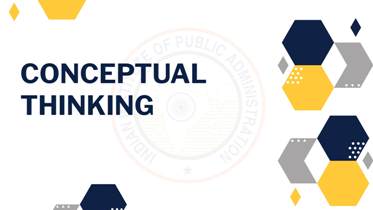Description
The etymological meaning of the term ‘concept’ indicates an abstract idea. Concepts though abstract ideas are containers of future realities. Conceptual thinking is the soft skill which facilitates conversion of these concepts into realities. Conceptual thinking involves deep understanding of the concepts, its multi-faceted linkages and causation factors and strategy for going beyond what is to what can be. This can be best illustrated with example. The person who expounds a mathematical proof and equally the person who follows the exposition is thinking conceptually. So is the person who is engaged in any kind of classification as also the judge who applies a legal statute to a state of affairs. Any child who uses a colour-word correctly proves himself thereby a conceptual thinker.
India’s Struggle for Freedom (abstract idea) under the leadership of Mahatma Gandhi is a live example of implementation of conceptual thinking. Sun never set in the vast British empire. The Empire had establishments in Africa, Asia, Europe, America, and numerous Islands across the globe. Roughly 25% of the earth landmass was in control of the British. It was a Herculean task to challenge the might of this empire for poor Indians. Gandhiji after having travelled the length and breadth of his subjugated country and after having observed constant exploitation of the poor masses at the hands of the British rulers evolved the twin tools of ‘Satyagraha’ and ‘Ahimsa’. To apply these tools for the struggle by the masses for emancipation from British rule was ‘out of the box thinking’. Soon the struggle for freedom converted into a Mass Civil Disobedience Movement signaling the death knell for British rule in India. This gradually resulted in the independence (reality today) of our country from British rule.
Conceptual Background
- What is Conceptual Thinking?
- Conceptual thinking is a thinking pattern that is designed by a concept or a mental model, not built on direct contemporary reality.
- Conceptual thinking is about large concepts, abstract thoughts, systems, and systemic thinking. Conceptual thinking is the big picture thinking or the macro-thinking rather than the details.
- Conceptual thinking is the ability to understand something at the abstract level, ability to see the big picture, see behind the curtain, the why, the cause and effect without having to physically observe something with your five senses. It is the ability to understand concepts behind what is talked about that cause it to make sense or help us to understand why it is happening, how it is happening and what we could do to alter the results. It also includes analysing hypothetical situations.
- It is akin to systemic thinking, the discipline that allows to change systems more effectively while acting according to the processes of the natural and economic world with the objective to create a unique solution that meets the expectations of all the parties involved.
- Conceptual thinking is not only an intellectual thinking but also emotional thinking.
- Strategy development is conceptual thinking.
- What is not Conceptual Thinking? It is not Concrete Thinking which is based on facts and logic. Concrete thinkers think in terms of think, analyse, device, calculate, parameters and practical details. It is neither literal interpretation of things nor sequential or linear presentation of facts or applying same linear logic to problem solving. Though the conceptual thinking may originate from criticism of results of a system it is not critical thinking.It is also not design thinking, but it can be an important tool is design thinking.
- What is the science behind Conceptual Thinking? At the general level, the biological machinery sustaining conceptual thinking has been identified as mainly involving three cerebral structures viz. the amygdala, the verbal areas of the neocortex and the hippocampus. These three structures have been observed to activate in a very specific sequence whenever a verbal stimulus generates the slightest feeling of discomfort in the amygdala, causing the individual to pay active attention to what this verbal stimulus reminds him of. The key role played in conceptual thinking by verbal stimuli is due to the human ability to use an articulated language
Curriculum/Resources
Reference
Books
- Conceptual Thinking- A Logical Inquiry by Stephan Korner, Dover Publications, 1959
- The Fifth Discipline: The Art & Practice of the Learning Organization Score Year of publication: 2006 Author: Peter Senge Articles
- Conceptual Thinking, Author(s): Walter Libby Source: The Scientific Monthly, Nov., 1922, Vol. 15, No. 5 (Nov., 1922), pp. 435-442 Published by: American Association for the Advancement of Science Stable ( https://www.jstor.org/stable/6404 accessed on 15 October 2021)
- The Mechanics of Conceptual Thinking, Author: André Michaud, Creative Education, 2019, 10, pp. 353-406 Published by: Scientific Research Publishing (https://www.scirp.org/journal/paperinformation.aspx?paperid=90657 (Accessed on 17 October 2021)
- Civil Services Competency Dictionary, GoI-UNDP Project: Strengthening Human Resource Management of Civil Service published by Training Division, Department of Personnel & Training, Government of India.
Report
- World Development Report 2015 -Mind, Society and Behaviour , World Bank
- New Education Policy 2020, Government of India Online Sources
- Hindi Movie -PM Narendra Modi at https://www.mxplayer.in/movie/watch-pm-narendra-modi( seen on 16 October 2021)
- Podcast https://thecompleteleader.org/conceptual-thinking (Accessed on 14 October 2021)
- Podcast https://thecompleteleader.org/blog/intro-conceptual-thinking-ep-1 (Accessed on 14 October 2021)
- Podcast https://thecompleteleader.org/blog/conceptual-thinking-series-ep-2 (Accessed on 14 October 2021)
- Podcast https://timesofindia.indiatimes.com/home/education/news/conceptual-thinking-to-make- students-look-beyond-books/articleshow/68688378.cms (Accessed on 14 October 2021)
- Podcast https://thecompleteleader.org/conceptual-thinking (Accessed on 11 October 2021)
- YouTube video on Concepts and Conceptual Thinking (https://www.bing.com/videos/search?q=Institute+on+Conceptual+thinking&qpvt=Institute+on+Co nceptual+thinking&view) (Accessed on 11 October 2021)
- Conceptual Thinking Mini-Lessons: Introduction and Explanation (https://www.youtube.com/watch?v=mLbgi8fzkVI&t=1s) (Accessed on 11 October 2021)
- How to apply Conceptual Thinking (https://www.youtube.com/watch?v=PmpmWnwrZ2Y) (Accessed on 15 October 2021)
- Conceptual Thinking for Holistic Development (https://www.youtube.com/watch?v=kytO5Gfhar8) (Accessed on 20 October 2021)
- TEDxRoma : Creative thinking - how to get out of the box and generate ideas: Giovanni Corazza (https://www.youtube.com/watch?v=bEusrD8g-dM ) (Accessed on 20 October 2021)
- Website of NITI Aayog at https://www.niti.gov.in/ (Accessed on 20 October 2021)
- Kallipolis: the City of the Ideal - PHDessay.com (Accessed on 28 October 2021)
Overview
